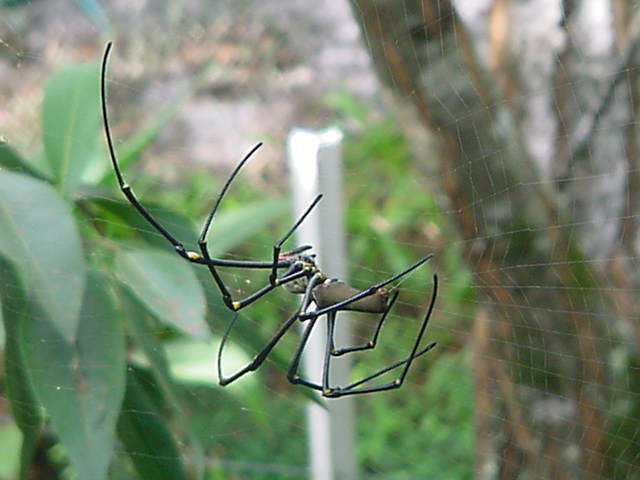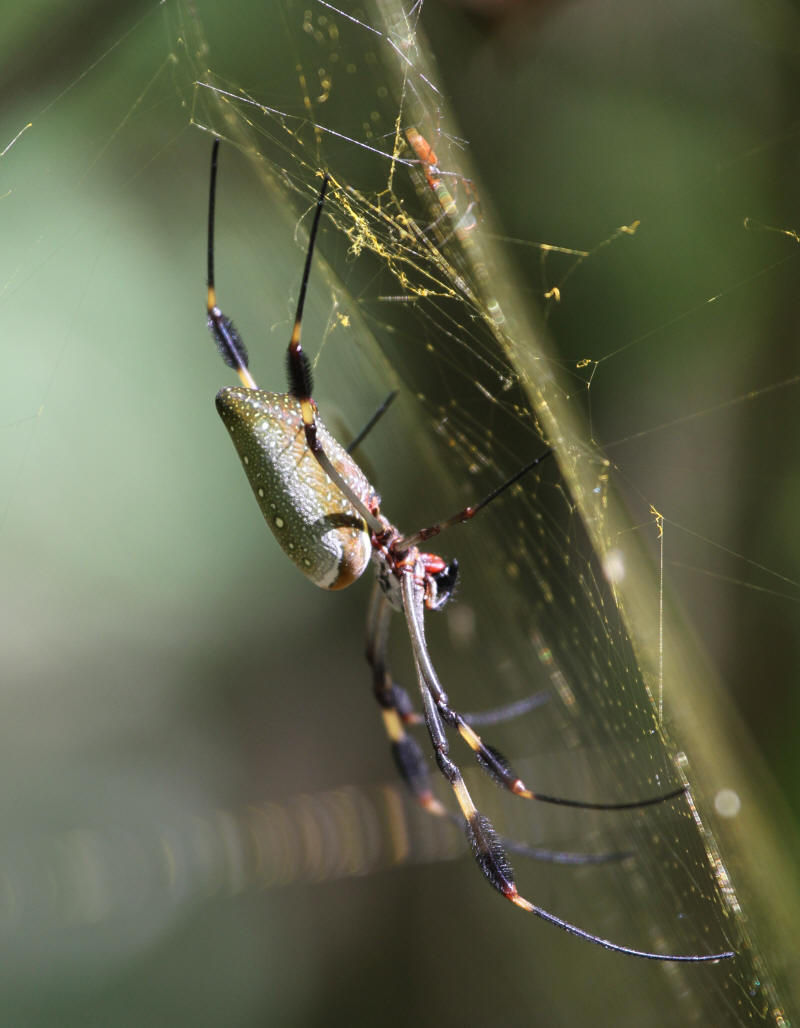



Golden Silk Orb Weaver
Here's some photos of Golden Silk Orb Weavers. In the US they call this nephila species Golden Silk Weavers and call the Black and Yellow Argiope a golden orb weaver, which is a bit confusing. In Australia they are called just Golden Orb Weavers. Golden silk orb weavers were moved from the Araneidae family (orbweavers) into the Tetragnathidae (longjawed orbweavers) a few years ago. Nephila clavipes is the only species in the Nephila genus that exists in the US. The venom of the golden silk orb-weaver is powerful, but not lethal to humans. Its venom is a neurotoxin similar to that of the black widow; however, its venom is not nearly as powerful. Its bite can cause local pain and redness with blisters forming. This bite usually resolves within 24 hours except for the bite mark. As the genus possesses relatively strong chelicerae, the bite could leave a scar on hard tissue (such as fingers). They are a great nuisance to people walking in the bush with their strong yellow sticky webs. The webs are made in open woods or edges of dense forest, usually attached to trees and low shrubs, although they may be in the tops of trees or between the wires of phone or electricity lines. Their prey consists of a wide variety of small to medium-sized flying insects, including flies, bees, wasps, and small moths and butterflies. N. clavipes (and many other Nephila species) are frequently victimized by Argyrodes, a genus of very small black-and-silver spiders that are kleptoparasitic. As many as a few dozen may infest a single Nephila web to feed from the host spider's captured prey. The frequent rebuilding or abandoning of webs by Nephila may be a tactic for controlling Argyrodes. Spiny orb-weaver spiders also inhabit the webs of Nephila in order to obtain food.
Click here for a story from Channel 9 about a Golden Silk Orb Weaver catching and eating a brown snake.
The different species featured below are: Nephila Edulis (Australia), Nephila Pilipes/Maculata (Australia), Nephila Clavipes (USA), Golden Orb Weavers (Africa), Golden Orb Weavers (Other Places)
Golden Orb Weavers (Australia) [top]
Nephila edulis is a species of large spider of the Nephilidae family. It is referred to the common name edible golden silk spider or golden silk orb-weaver. It occurs widely in Australia, where it is found in both tropical and temperate regions, and in parts of New Guinea and New Caledonia. It has a large body size variability, females can reach a body length of about 23 millimetres, males about 6 mm. The cephalothorax is black with a white pattern on the back, and a yellow underside; the abdomen is grey to brown. The web is about 1 metre in diameter and protected on one or both sides by a strong "barrier" web. N. edulis breeds from February to May, and produces an average of 380 eggs. The species name edulis means "edible" in Latin. While it is not entirely clear why this particular species is considered edible, it is known that several Nephila species are considered a delicacy in New Guinea, where they are plucked by the legs from their webs and lightly roasted over an open fire. The species was first collected and named by Jacques Labillardiere, in Relation du Voyage à la Recherche de la Pérouse (1799), becoming the second Australian spider to described by a European naturalist. - Wikipedia




















Nephila pilipes/maculata (Australia) [top]
Nephila pilipes is a species of golden orb-web spider and is also called Nephila maculata. It can be found in Japan, China, Taiwan, Singapore, Myanmar, Philippines, Sri Lanka, India, Papua New Guinea, and Northern Australia. It is commonly found in primary and secondary forests and gardens. Females are large and grow to a body size of 30-50mm, with males growing to 5–6 mm. The Nephila pilipes' web is vertical with a fine irregular mesh and not symmetrical, with the hub is usually nearer the top. Rather than egg sacks being hung in the web, a pit is dug which is then covered with plant debris or soil. The first, second and fourth pairs of legs of juvenile females have dense hairy brushes, but as the spider matures these brushes disappear. The last 3 photos below are Nephiles Maculata. Wikipedia










Nephila Clavipes (United States) [top]
Nephila clavipes is the only species in the Nephila genus that exists in the US. In the United States, it ranges throughout the coastal southeast and inland, from North Carolina to Texas. Its distribution in many regions seems localized, and it may be completely absent (or just hard to find) over wide areas. Conversely, in some arboreal or swampy nooks, adults and their webs can be found in large concentrations, especially near the coast. Golden orb-weavers are especially numerous in the time after summer and before fall in the Southeastern and Southern United States. This species is widespread - and often common - in large parts of Central America and warmer regions of South America. The web of a mature female can reach one meter in width, the yellow threads appearing as a rich gold in sunlight. The female is much larger than the male. Males come into the female's web for copulating. After mating, the female spins an egg sac on a tree, laying hundreds of eggs in one sac. While it is venomous to humans, it will only bite if in danger. The bite is usually relatively harmless and only leads to slight redness and localized pain. The silk of N. clavipes has recently been used to help in mammalian neuronal regeneration. In vitro experiments showed that a single thread of silk can lead a severed neuron through the body to the site from which it was severed. With a tensile strength of 4×109 N/m2, it exceeds that of steel by a factor of six. It is not recognized by the immune system. They are a great nuisance to people walking in the bush with their strong yellow sticky webs. The webs are made in open woods or edges of dense forest, usually attached to trees and low shrubs, although they may be in the tops of trees or between the wires of phone or electricity lines. Their prey consists of a wide variety of small to medium-sized flying insects, including flies, bees, wasps, and small moths and butterflies. N. clavipes (and many other Nephila species) are frequently victimized by Argyrodes, a genus of very small black-and-silver spiders that are kleptoparasitic. As many as a few dozen may infest a single Nephila web to feed from the host spider's captured prey. The frequent rebuilding or abandoning of webs by Nephila may be a tactic for controlling Argyrodes. Spiny orb-weaver spiders also inhabit the webs of Nephila in order to obtain food.

























Nephila Sp. (Africa) [top]
Here's some photos of Golden Orb Weavers from Africa. I am not sure of their exact species so if anyone can help out, please email me. They are from Kenya, Mozambique, Nigeria, Sierra Leone, Congo and South Africa (the majority of the photos). I will put where they are from on the photos.

























Nephila Sp. (Other places) [top]
Here's some photos of Golden Orb Weavers from other tropical places. Once again, if anyone can ID them, please email me. I think some of the ones from Mexico are the Us Version Nephila Clavipes. Check the photo for the locations.



































